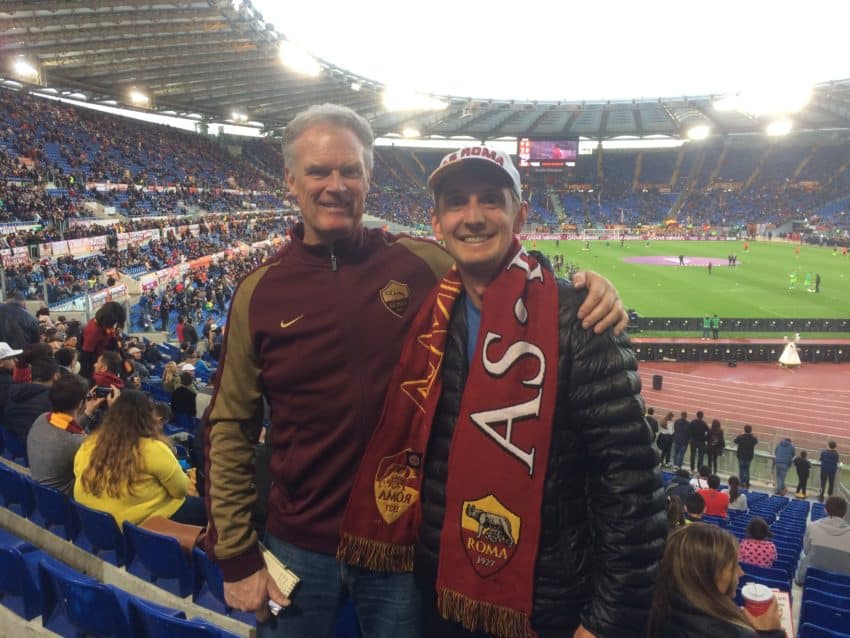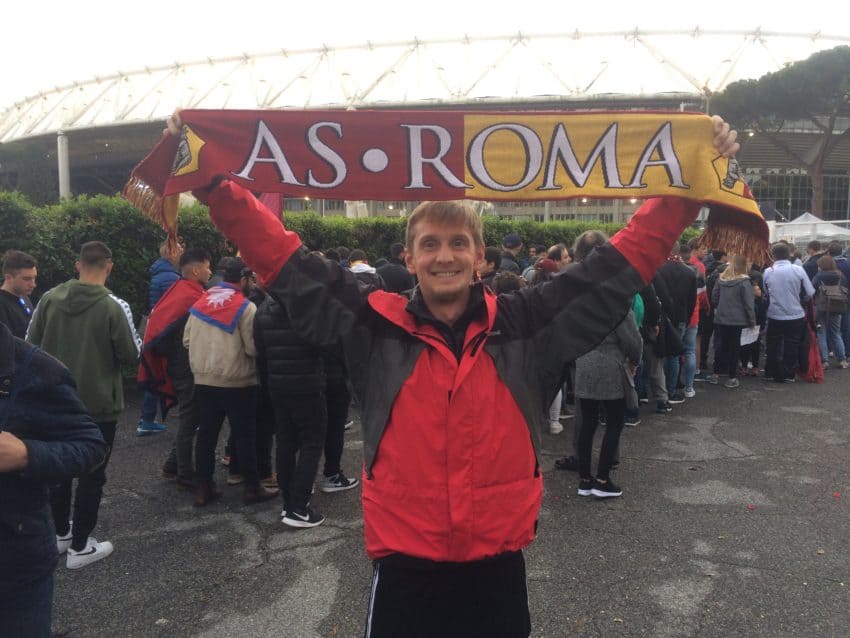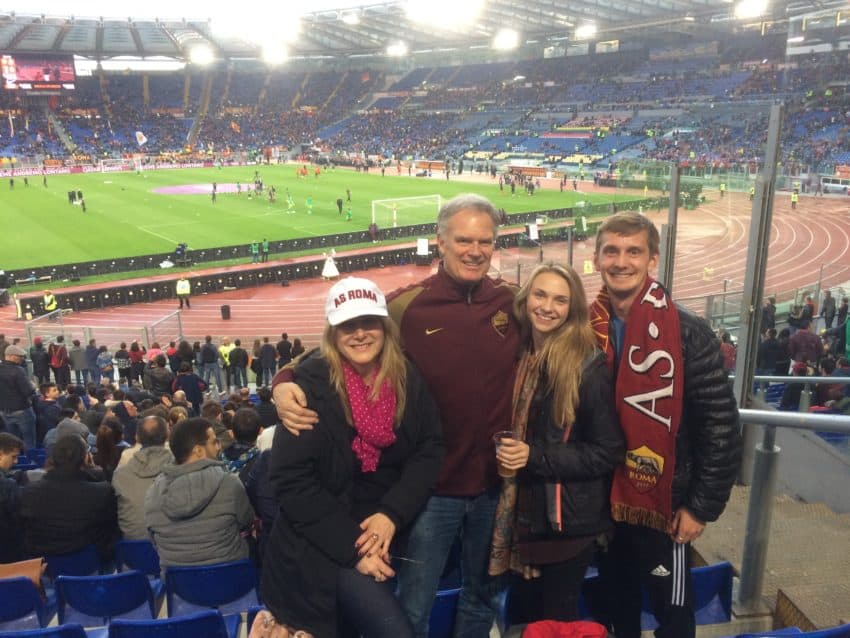Nephew’s visit to Roma-Juventus adds perspective to U.S. soccer woes

My nephew from California and his girlfriend are staying at my place in Rome for a week, mixing in some wine, pasta and art with his passion for soccer. His first European soccer match was Barcelona’s 3-0 win over Liverpool in the Champions League semifinals May 1 and then the couple joined Marina and me for Roma’s 2-0 win over evil Juventus Sunday night. He has nearly worn out his cell video of Lionel Messi’s epic free kick goal. I think he may have slept Sunday night wearing his new AS Roma scarf.
We both quasi represent the world’s two biggest soccer disappointments. Neither the United States nor Italy qualified for last year’s World Cup, ending a string of 21 combined straight appearances. However, Italy has won four World Cups. Last year’s pratfall is considered a blip on its historical radar.
But the U.S. remains a sport-wide mystery. Despite 325 million people, a rich federation, a successful pro league and a sport that has exploded at the youth level since the 1970s, the U.S. has only gone as far as the World Cup quarterfinals once. Last year, it didn’t even qualify despite playing in CONCACAF, world soccer’s equivalent to a sunset stroll.
My nephew, Spencer Treffry, has qualified insight into the problem. At 28, he was a product of the U.S.’ elite Olympic Development Program and saw first hand the problems the U.S. has had and why it hasn’t caught up with Europe’s elite. He started playing in kindergarten, made traveling teams when he became old enough and developed into the Oregon State Player of the Year in 2008, leading Eugene’s Churchill High to the state title. Deemed too thin (he was a wispy 5-foot-10, 120 pounds) for a college scholarship, he continued playing club ball at Cal Poly-San Luis Obispo and continues playing city league soccer today around their home in Pismo Beach, California.
As he grew up, I tweaked his interest in world soccer by sending him jerseys during my various travels, from the Brazil national team to Zenit of St. Petersburg, Russia. He even has one from Togo, bought in Munich when I covered the 2006 World Cup. His Palermo jersey was always one of his most popular, due to its pink color and his security in his own manhood.
The U.S.’ biggest problem, he says, isn’t at the national level where it is on its fourth coach in three years. It’s at the youth level where he saw first hand the differences between the American and European approaches.
“I was lucky to have some good coaches growing up, but most people don’t,” he said. “Most youth coaches in the U.S. are just dads. They played baseball, football, basketball and their second grader needs a soccer coach. So they’re out there running kids around and making sure everyone’s having fun, but they have no idea how to play the game.”
Growing up in Eugene, his first club coaches were English, he had another from Germany and one American who played professionally in Costa Rica. They knew what they were doing and did more than just roll out the balls. The American introduced them to futsal, soccer played on a miniature field, forcing you to develop skills in tighter spaces. It’s very popular in South America.
“He brought little goals out on the tennis court, brought speakers out and played samba music,” he said. “Bounce to the rhythm and go have fun. You see it in the way Barcelona plays, the way they ping the ball. It’s very natural, very flowy.”
I don’t agree that the problem is too much competition from other sports. The U.S. has the population. When I worked in suburban Seattle I wrote a story about how youth soccer numbers had passed baseball’s in the state of Washington. I quoted officials saying it shows the U.S. would someday be the world’s greatest soccer power.
I wrote that story in 1979.
Even today, 2.5 million boys play youth soccer in the U.S., almost as many as the 3 million who play youth baseball. Croatia made last year’s World Cup finals and its entire population is only 4.1 million. The problem is just because American youths like to play soccer, they don’t necessarily like to watch it.
Spencer didn’t start watching soccer until he reached college.
“I started watching it and my game immediately elevated, absolutely,” he said. “When we were in Florence we were talking to the guy who owned our B&B who’s an artist. He was talking about you immerse yourself in this art community that is Florence and go look at and watch what the masters did and then you go back and try to apply that in your apartment. I always draw these metaphors back to soccer. It’s the same thing. You watch somebody do something and get a spark of an idea and then you go back and apply it.”
The situation in the U.S. is changing. The MLS’ average attendance last year of 21,876 is nearly on a par with Serie A’s 24,767. It has expanded to 24 teams and each club must now have its own youth academy. Even the national team has gone 3 wins, 1 tie and no losses in friendlies under new coach Gregg Berhalter.
NBC has the English Premier League contract but even in Spencer’s soccer-crazed area of California’s Central Coast, he couldn’t find the Real Madrid-Barcelona game on TV at noon California time.
Unfortunately, he did find last year’s United States-Trinidad & Tobago match in which the U.S. only had to tie in a half-empty Caribbean stadium where a good portion of the fans were American. They lost, 2-1, and combined with Honduras’ win over Mexico, the U.S. was sent home as well as coach Bruce Arena.
“Totally uninspired, uncreative soccer,” Spencer said. “I am optimistic now that we’ve basically had a change of guard. This last World Cup with that result basically said bye-bye to the players entrenched for the last 10 years. We’re not going to see (Michael) Bradley in the starting lineup anymore. (Jozy) Altidore is probably out the door. (Tim) Howard. (Clint) Dempsey, all these guys who were good players when they were young.
“The U.S. wasn’t terrible on the world stage. They just didn’t turn over any new talent for 10 years. It’s always hard for me to watch the U.S. men’s soccer team and believe those are the 11 best players in the country.

***
He was about to see the best player in the world and arguably in history. After seeing Messi light up Liverpool (before, of course, Barcelona folded like a lawn chair in the second leg), Spencer was going to see Juventus’ Cristiano Ronaldo. Every country in the world has sports bars debating whether Messi or Ronaldo deserve the crown and then they throw in Pele and Maradona in the GOAT argument.
Marina is a third-generation Roman who has plied me with AS Roma gifts for four years. She is a romanista but too much of a fashionista to wear anything with a logo depicting a nursing she-wolf. I bought her a generic AS Roma ballcap for the game.
“John,” she said as she reluctantly put it on for the walk to the stadium, “this is love.”
The game had plenty of drama. With three games left, sixth-place Roma stood four points behind Inter Milan, which won Saturday, for next season’s fourth and final Champions League spot and three behind AC Milan. After Sunday, two games remain in the season although Milan has three.
Considering the mess Roma has been in, it’s a remarkable achievement. It fired its coach after getting bounced from this season’s Champions League and the current one is caretaker and Rome’s native son Claudio Ranieri. The sporting director quit in protest of the firing, and the goalie got benched. The best player the last month has probably been new goalkeeper Antonio Mirante who’s about my age.
Olympic Stadium was packed with 50,000 people to watch Roma try and save its season against a Juventus team that clinched its unprecedented eighth straight Serie A title by about Easter. I was hoping Juventus showed up wearing little pointy party hats or Ronaldo hung over. Nope. He doesn’t drink.
Juventus played its top lineup and previewed its next season’s uniform, a sharp black-and-white checked number that Juve fans have destroyed on social media. Juve played loose and free and was gunning from all angles. Mirante made a brilliant save in the sixth minute on a one-on-one encounter and then stopped Ronaldo 10 minutes later.
I’ve watched enough soccer to know the biggest gap between the U.S. and the soccer powers is the creativity in shot making. U.S. players don’t play on the streets or beaches. You don’t see the shots you see in Europe, or even the first 16 minutes Sunday night.
Spencer agreed.

“It’s the touch before the shot,” he said. “Give yourself an opportunity to take a controlled shot, to curl a ball into the far post or put it inside the near post. You’re not reaching for it. You’re not stretching or off balance.
“(These guys) land on their feet after they take a shot. You watch a lot of American players and they’re just swinging for a ball and they fall over afterwards because they’re off balance.”
It’s 0-0 at halftime and the second half the Roma ultras in Curva Sud are in full throttle as they greet an injured Juventus player with, “DEVI MORIRE! DEVI MORIRE!” (YOU MUST DIE! YOU MUST DIE!).
Ronaldo piqued Spencer’s dream as he scored on a beautiful one on one breakaway but was called offsides. Both teams were pretty sloppy until Alessandro Florenzi, the Roma captain who grew up in the heart of Centro Storico, looped a ball over ex-Roma goalie Wojciech Szczesny for a 1-0 lead in the 80th minute. Edin Dzeko, Roma’s up-and-down star striker, scored on a 3-on-1 in stoppage time for a desperately needed 2-0 win.
Marina screamed like a season ticket holder. We all high fived. We stuck around to listen to the 50,000 fans sway together singing “Grazie, Roma.” After a long walk to the subway and post-game beer, I asked Spencer what he, an American soccer fanatic who knows the game, thought of the atmosphere in Europe.
“It’s awesome for me to get to watch professional soccer at this level,” he said. “To have a fan section that really knows the game, watching. Even the people in front of us: father, son, younger son, all leaning forward watching the game.
“We need that kind of passion and education.”


May 13, 2019 @ 2:56 pm
Enjoyed your post. Haven’t felt soccer fever in years. Manchester United was my team with George Best. Dates me I know. Has the soccer fan violence diminished in the past few years? Haven’t read much about that. Never had it. Then they had and now hopefully no more.
May 13, 2019 @ 3:17 pm
Thanks, Sandra. Violence is alive and well. Particularly with Ajax. Roma has had its share and Lazio is just plain fascists.
May 17, 2019 @ 5:36 am
Ah-ehm… four world cups! The biggest difference between US and European/Latin football I’ve seen in the 2006 World Cup was defence. American players were really aggressive on the ball, often tackling ball, foot and ankle. Apart from being ugly, it doesn’t work; Paolo Maldini, a man I’m not afraid to call one of the best defenders ever though I’m not a Milanista, seldom tackled. He just was there.
May 20, 2019 @ 3:25 pm
Also true… I had a coaches tell our teams that slide tackling is an absolute last resort. Its more a sign of a bad defense and being out of position. If your in the right spot, you can stay on your feet and win the ball. Assuming of course your not guarding Messi…
May 20, 2019 @ 3:29 pm
Great article! Awesome to see my best friend living his dream, getting to see the best “soccer” in the world with his loved ones! Looking good Spencer!! I am so jealous!
May 20, 2019 @ 6:38 pm
Thanks, TJ. I wanted him to get the full Roman soccer experience but no fans made monkey sounds or knifed anyone.